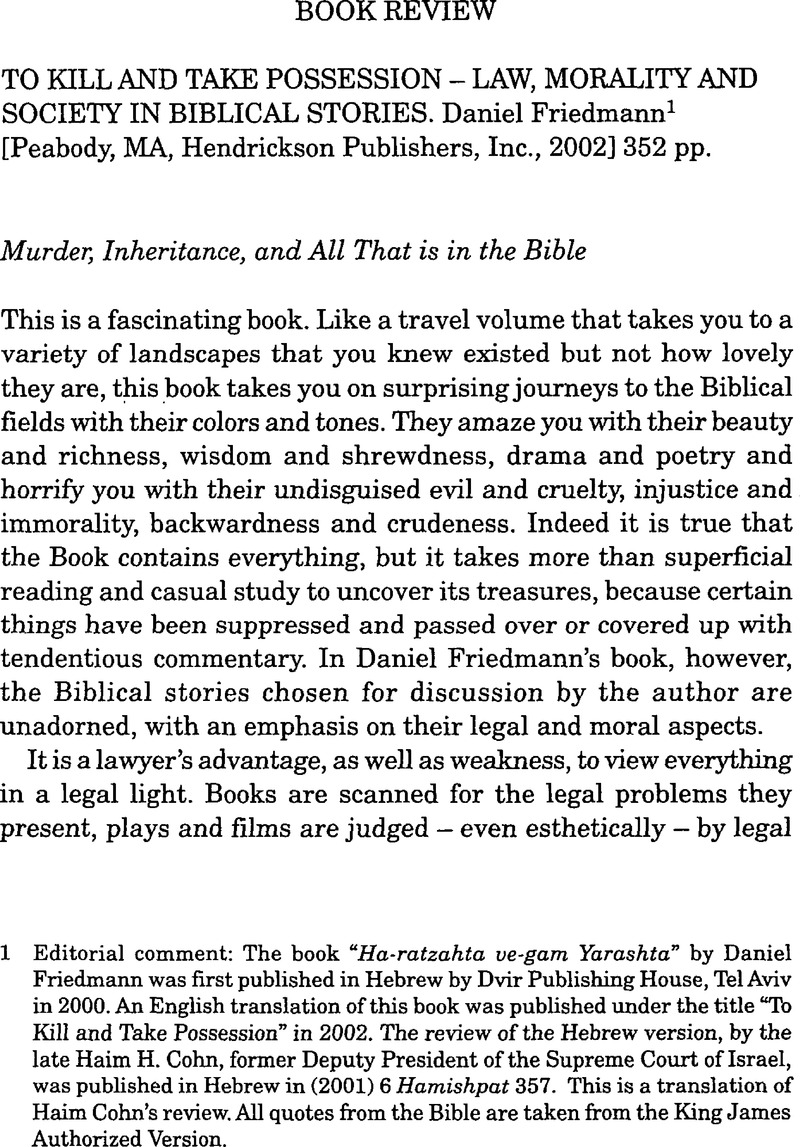No CrossRef data available.
Published online by Cambridge University Press: 04 July 2014

1 Editorial comment: The book “Ha-ratzahta ve-gam Yarashta” by Daniel Friedmann was first published in Hebrew by Dvir Publishing House, Tel Aviv in 2000. An English translation of this book was published under the title “To Kill and Take Possession” in 2002. The review of the Hebrew version, by the late Cohn, Haim H., former Deputy President of the Supreme Court of Israel, was published in Hebrew in (2001) 6 Hamishpat 357Google Scholar. This is a translation of Haim Cohn's review. All quotes from the Bible are taken from the King James Authorized Version.
2 Friedmann, Daniel, To Kill and Take Possession (Peabody, MA, Hendrickson Publishers, 2002), 92Google Scholar.
3 Numbers 35:24.
4 Friedmann, supra n. 2, at 286.
5 II Samuel 14:5–7.
6 Friedmann, supra n. 2, at 289.
7 “And David executed judgment unto all his people,” II Samuel 8:15.
8 Nor, to the best of my knowledge, does the Talmud document any such case.
9 Friedmann, supra n. 2, at 288.
10 Mishnah, Makot, 2:7.
11 Numbers 35:19.
12 Cohen, Boaz, Jewish and Roman Law – A Comparative Study (New York, The Jewish Theological Seminary of America, 1966), 626Google Scholar.
13 Maimonides, , Hilkhot Rozeah ushmirat nefesh, 1:2Google Scholar.
14 Numbers 35:31.
15 Maimonides, supra n. 13, at 1:4.
16 I Kings 13.
17 Friedmann, supra n. 2, at 112–127.
18 Leviticus 24:10–17.
19 Numbers 15:32–36.
20 Friedmann, supra n. 2, at 125–126.
21 I Kings 20:35–36.
22 I Samuel 22; Friedmann, supra n. 2, at 128.
23 Genesis 20:2; Friedmann, ibid., at 62–63, 211.
24 Genesis 20:3–7.
25 Genesis 12:12–15.
26 Genesis 12:18.
27 Friedmann, supra n. 2, at 63.
28 Ibid., at 12.
29 Ibid., at 186.
30 Isaiah 55:8–9.
31 II Samuel 6:3–9.
32 Leviticus 4:15.
33 Leviticus 7:9.
34 Rashi, Sotah, 35:1.
35 Ibid.; the story appears also in I Chronicles 13, where the text is plain: “And the anger of the Lord was kindled against Uzza, and he smote him, because he put his hand to the ark, and there he died before God.”
36 I Samuel 6:1–19.
37 The sages of the Talmud interpreted this to mean that seventy men died, each of whom was equal to fifty thousand; Radak held that the conjunction is missing and the dead numbered fifty thousand and seventy.
38 Sotah 35:1.
39 Ibid.
40 Friedmann, supra n. 2, at 173.
41 Deuteronomy 4:45.
42 Yoma 67:2.
43 Friedmann, supra n. 2, at 174.
44 Ibid., at 2.
45 Ibid., at 176–178.
46 Ibid., at 178.
47 Ibid., at 188.